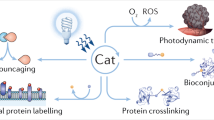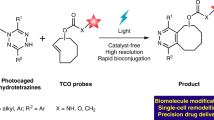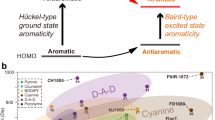Abstract
State-of-the-art photoactivation strategies in chemical biology provide spatiotemporal control and visualization of biological processes. However, using high-energy light (λ < 500 nm) for substrate or photocatalyst sensitization can lead to background activation of photoactive small-molecule probes and reduce its efficacy in complex biological environments. Here we describe the development of targeted aryl azide activation via deep red-light (λ = 660 nm) photoredox catalysis and its use in photocatalysed proximity labelling. We demonstrate that aryl azides are converted to triplet nitrenes via a redox-centric mechanism and show that its spatially localized formation requires both red light and a photocatalyst-targeting modality. This technology was applied in different colon cancer cell systems for targeted protein environment labelling of epithelial cell adhesion molecule (EpCAM). We identified a small subset of proteins with previously known and unknown association to EpCAM, including CDH3, a clinically relevant protein that shares high tumour-selective expression with EpCAM.

This is a preview of subscription content, access via your institution
Access options
Access Nature and 54 other Nature Portfolio journals
Get Nature+, our best-value online-access subscription
$29.99 / 30 days
cancel any time
Subscribe to this journal
Receive 12 print issues and online access
$259.00 per year
only $21.58 per issue
Buy this article
- Purchase on Springer Link
- Instant access to full article PDF
Prices may be subject to local taxes which are calculated during checkout






Similar content being viewed by others
Data availability
Data supporting the main findings of this study are available in the Article, Supplementary Information and Source Data. All Supplementary figures, experimental details and synthesis information are included in the Supplementary Information. Unprocessed proteomics results are available in the Supplementary Data Table. Raw proteomics data are deposited on MassIVE (public data access: ftp://massive.ucsd.edu/MSV000088973/). Source data are provided with this Paper.
References
Kotzyba-Hibert, F., Kapfer, I. & Goeldner, M. Recent trends in photoaffinity labeling. Angew. Chem. Int. Ed. 34, 1296–1312 (1995).
Murale, D. P., Hong, S. C., Haque, Md. M. & Lee, J.-S. Photo-affinity labeling (PAL) in chemical proteomics: a handy tool to investigate protein-protein interactions (PPIs). Proteome Sci. 15, 14 (2017).
Sadhu, K. K., Eierhoff, T., Römer, W. & Winssinger, N. Photoreductive uncaging of fluorophore in response to protein oligomers by templated reaction in vitro and in cellulo. J. Am. Chem. Soc. 134, 20013–20016 (2012).
Geng, J. et al. Switching on prodrugs using radiotherapy. Nat. Chem. 13, 805–810 (2021).
Holland, J. P., Gut, M., Klingler, S., Fay, R. & Guillou, A. Photochemical reactions in the synthesis of protein-drug conjugates. Chem. Eur. J. 26, 33–48 (2020).
Fantoni, N. Z., El-Sagheer, A. H. & Brown, T. A hitchhiker’s guide to click-chemistry with nucleic acids. Chem. Rev. 121, 7122–7154 (2021).
Deb, T., Tu, J. & Franzini, R. M. Mechanisms and substituent effects of metal-free bioorthogonal reactions. Chem. Rev. 121, 6850–6914 (2021).
Heiss, T. K., Dorn, R. S. & Prescher, J. A. Bioorthogonal reactions of triarylphosphines and related analogues. Chem. Rev. 121, 6802–6849 (2021).
Chin, J. W. et al. Addition of p-azido-l-phenylalanine to the genetic code of Escherichia coli. J. Am. Chem. Soc. 124, 9026–9027 (2002).
Kotani, N. et al. Biochemical visualization of cell surface molecular clustering in living cells. Proc. Natl Acad. Sci. USA 105, 7405–7409 (2008).
Gritsan, N. P. & Platz, M. S. Kinetics, spectroscopy and computational chemistry of arylnitrenes. Chem. Rev. 106, 3844–3867 (2006).
DeGraff, B. A., Gillespie, D. W. & Sundberg, R. J. Phenyl nitrene. Flash photolytic investigation of the reaction with secondary amines. J. Am. Chem. Soc. 96, 7491–7496 (1974).
Li, Y.-Z., Kirby, J. P., George, M. W., Poliakoff, M. & Schuster, G. B. 1,2-Didehydroazepines from the photolysis of substituted aryl azides: analysis of their chemical and physical properties by time-resolved spectroscopic methods. J. Am. Chem. Soc. 110, 8092–8098 (1988).
Marcinek, A. & Platz, M. S. Deduction of the activation parameters for ring expansion and intersystem crossing in fluorinated singlet phenylnitrenes. J. Phys. Chem. 97, 12674–12677 (1993).
Liu, L.-H. & Yan, M. Perfluorophenyl azides: new applications in surface functionalization and nanomaterial synthesis. Acc. Chem. Res. 43, 1434–1443 (2010).
Xie, S., Sundhoro, M., Houk, K. N. & Yan, M. Electrophilic azides for materials synthesis and chemical biology. Acc. Chem. Res. 53, 937–948 (2020).
Poe, R., Schnapp, K., Young, M. J. T., Grayzar, J. & Platz, M. S. Chemistry and kinetics of singlet pentafluorophenylnitrene. J. Am. Chem. Soc. 114, 5054–5067 (1992).
Soundararajan, N. & Platz, M. S. Descriptive photochemistry of polyfluorinated azide derivatives of methyl benzoate. J. Org. Chem. 55, 2034–2044 (1990).
Marcinek, A. et al. Unusually long lifetimes of the singlet nitrenes derived from 4-azido-2,3,5,6-tetrafluorobenzamides. J. Phys. Chem. 98, 412–419 (1994).
Schnapp, K. A., Poe, R., Leyva, E., Soundararajan, N. & Platz, M. S. Exploratory photochemistry of fluorinated aryl azides. Implications for the design of photoaffinity labeling reagents. Bioconjug. Chem. 4, 172–177 (1993).
Keana, J. F. W. & Cai, S. X. New reagents for photoaffinity labeling: synthesis and photolysis of functionalized perfluorophenyl azides. J. Org. Chem. 55, 3640–3647 (1990).
Kanakarajan, K., Goodrich, R., Young, M. J. T., Soundararajan, S. & Platz, M. S. EPR spectroscopy of triplet aryl nitrenes covalently bound to α-chymotrypsin. Application of low-temperature methods to photoaffinity labeling. J. Am. Chem. Soc. 110, 6536–6541 (1988).
Ryu, K. A., Kaszuba, C. M., Bissonnette, N. B., Oslund, R. C. & Fadeyi, O. O. Interrogating biological systems using visible-light-powered catalysis. Nat. Rev. Chem. 5, 322–337 (2021).
Huang, H. et al. Targeted photoredox catalysis in cancer cells. Nat. Chem. 11, 1041–1048 (2019).
Geri, J. B. et al. Microenvironment mapping via Dexter energy transfer on immune cells. Science 367, 1091–1097 (2020).
Wright, M. H. & Sieber, S. A. Chemical proteomics approaches for identifying the cellular targets of natural products. Nat. Prod. Rep. 33, 681–708 (2016).
Liu, J., Hadad, C. M. & Platz, M. S. The reaction of triplet nitrenes with oxygen: a computational study. Org. Lett. 7, 549–552 (2005).
Chen, Y., Kamlet, A. S., Steinman, J. B. & Liu, D. R. A biomolecule-compatible visible-light-induced azide reduction from a DNA-encoded reaction-discovery system. Nat. Chem. 3, 146–153 (2011).
Farney, E. P. & Yoon, T. P. Visible-light sensitization of vinyl azides by transition-metal photocatalysis. Angew. Chem. Int. Ed. 53, 793–797 (2014).
Wang, H. et al. Selective mitochondrial protein labeling enabled by biocompatible photocatalytic reactions inside live cells. JACS Au. 1, 1066–1075 (2021).
Ravetz, B. D. et al. Development of a platform for near-infrared photoredox catalysis. ACS Cent. Sci. 6, 2053–2059 (2020).
Matikonda, S. S. et al. Mechanistic evaluation of bioorthogonal decaging with trans-cyclooctene: the effect of fluorine substituents on aryl azide reactivity and decaging from the 1,2,3-triazoline. Bioconjugate Chem. 29, 324–334 (2018).
Ásgeirsson, V. et al. Nudged elastic band method for molecular reactions using energy-weighted springs combined with eigenvector following. J. Chem. Theory Comput. 17, 4929–4945 (2021).
Bissonnette, N. B. et al. Design of a multiuse photoreactor to enable visible-light photocatalytic chemical transformations and labeling in live cells. ChemBioChem 21, 3555–3562 (2020).
Keller, L., Werner, S. & Pantel, K. Biology and clinical relevance of EpCAM. Cell Stress 3, 165–180 (2019).
Macdonald, J. et al. EpCAM immunotherapy versus specific targeted delivery of drugs. Cancers 10, 19 (2018).
Shafraz, O., Xie, B., Yamada, S. & Sivasankar, S. Mapping transmembrane binding partners for E-cadherin ectodomains. Proc. Natl Acad. Sci. USA 117, 31157–31165 (2020).
Szklarczyk, D. et al. The STRING database in 2021: customizable protein-protein networks, and functional characterization of user-uploaded gene/measurement sets. Nucleic Acids Res. 49, D605–D612 (2021).
Pan, M. et al. Interactome analysis reveals endocytosis and membrane recycling of EpCAM during differentiation of embryonic stem cells and carcinoma cells. iScience 24, 103179 (2021).
Huttlin, E. L. et al. Architecture of the human interactome defines protein communities and disease networks. Nature 545, 505–509 (2017).
Chatr-aryamontri, A. et al. The BioGRID interaction database: 2017 update. Nucleic Acids Res. 45, D369–D379 (2017).
Bechtel, T. J., Reyes-Robles, T., Fadeyi, O. O. & Oslund, R. C. Strategies for monitoring cell–cell interactions. Nat. Chem. Biol. 17, 641–652 (2021).
Reiser, A., Willets, F. W., Terry, G. C., Williams, V. & Marley, R. Photolysis of aromatic azides. Part 4—Lifetimes of aromatic nitrenes and absolute rates of some of their reactions. Trans. Faraday Soc. 64, 3265–3275 (1968).
Bausch-Fluck, D. et al. The in silico human surfaceome. Proc. Natl Acad. Sci. USA 115, E10988–E10997 (2018).
Carlson, B., Phelan, G. D., Benedict, J. B., Kaminsky, W. & Dalton, L. Crystal structures and luminescence properties of osmium complexes of cis-1,2-vinylenebis(diphenylarsine) and pyridyl ligands: possible evidence for metal d, ligand d backbonding. Inorg. Chim. Acta 359, 1093–1102 (2006).
Towns, J. et al. XSEDE: accelerating scientific discovery. Comput. Sci. Eng. 16, 62–74 (2014).
Acknowledgements
Research was supported by the NIH National Institute of General Medical Sciences (R01-GM125206) and gifts from Merck & Co., Inc. J.L.W was funded in part by the Columbia Center for Computational Electrochemistry (CCCE). This work used the Extreme Science and Engineering Discovery Environment (XSEDE), which is supported by National Science Foundation grant no. ACI-154856246. In particular, we used San Diego Computing Center’s Expanse resources under allocation ID COL151.
Author information
Authors and Affiliations
Contributions
N.E.S.T., K.A.R., R.C.O., O.O.F. and T.R. conceived the work. N.E.S.T., K.A.R., A.K.O., D.C.C., R.C.O., O.O.F. and T.R. designed and executed experiments. N.E.S.T., K.A.R., D.C.C., R.C.O., O.O.F. and T.R. interpreted results. J.L.W. and D.R.R. designed and executed chemistry-based computations. J.L.W. and D.R.R. interpreted chemistry-based computational results. N.E.S.T., K.A.R., R.C.O., O.O.F. and T.R. wrote the manuscript, with input from all authors.
Corresponding authors
Ethics declarations
Competing interests
K.A.R., A.K.O., R.C.O. and O.O.F. were employed by Merck Sharp & Dohme Corp., a subsidiary of Merck & Co., during the experimental planning, execution and/or preparation of this manuscript. The remaining authors declare no competing interests.
Peer review
Peer review information
Nature Chemistry thanks Robin Bon and the other, anonymous, reviewer(s) for their contribution to the peer review of this work.
Additional information
Publisher’s note Springer Nature remains neutral with regard to jurisdictional claims in published maps and institutional affiliations.
Supplementary information
Supplementary Information
Supplementary Figs. 1–44, NMR and HRMS data of all new compounds, uncropped western blot images of Supplementary figures.
Supplementary Table 1
Excel-based table listing processed proteomics data for EpCAM-targeted proximity labelling.
Supplementary Table 2
Excel-based table listing pre-processed proteomics data for EpCAM-targeted proximity labelling.
Supplementary Data 1
Source data for Supplementary figures.
Supplementary Data 2
Computational cartesian coordinates.
Source data
Source Data Fig. 2B
UV-vis source data for Fig 2b.
Source Data Fig. 5
Statistical source data for Fig. 5b,c.
Source Data Fig. 5_2
Unprocessed western blots for Fig. 5b,c.
Source Data Fig. 6
Unprocessed western blot for Fig. 6b.
Rights and permissions
Springer Nature or its licensor holds exclusive rights to this article under a publishing agreement with the author(s) or other rightsholder(s); author self-archiving of the accepted manuscript version of this article is solely governed by the terms of such publishing agreement and applicable law.
About this article
Cite this article
Tay, N.E.S., Ryu, K.A., Weber, J.L. et al. Targeted activation in localized protein environments via deep red photoredox catalysis. Nat. Chem. 15, 101–109 (2023). https://doi.org/10.1038/s41557-022-01057-1
Received:
Accepted:
Published:
Issue Date:
DOI: https://doi.org/10.1038/s41557-022-01057-1
This article is cited by
-
Bioorthogonal photocatalytic proximity labeling in primary living samples
Nature Communications (2024)



